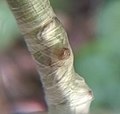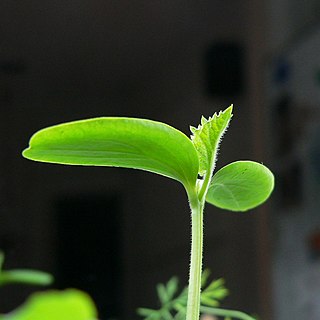
In botany, a plant shoot consists of any plant stem together with its appendages like leaves, lateral buds, flowering stems, and flower buds. The new growth from seed germination that grows upward is a shoot where leaves will develop. In the spring, perennial plant shoots are the new growth that grows from the ground in herbaceous plants or the new stem or flower growth that grows on woody plants.

Fruit tree propagation is usually carried out vegetatively (non-sexually) by grafting or budding a desired variety onto a suitable rootstock.

Vegetative reproduction is any form of asexual reproduction occurring in plants in which a new plant grows from a fragment or cutting of the parent plant or specialized reproductive structures, which are sometimes called vegetative propagules.

Budding or blastogenesis is a type of asexual reproduction in which a new organism develops from an outgrowth or bud due to cell division at one particular site. For example, the small bulb-like projection coming out from the yeast cell is known as a bud. Since the reproduction is asexual, the newly created organism is a clone and excepting mutations is genetically identical to the parent organism. Organisms such as hydra use regenerative cells for reproduction in the process of budding.
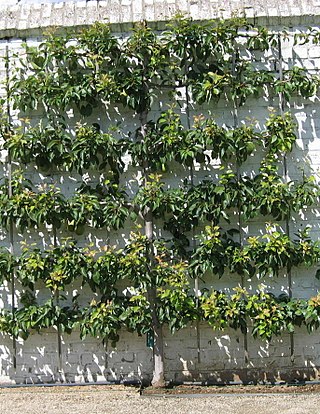
Espalier is the horticultural and ancient agricultural practice of controlling woody plant growth for the production of fruit, by pruning and tying branches to a frame. Plants are frequently shaped in formal patterns, flat against a structure such as a wall, fence, or trellis, and also plants which have been shaped in this way.

Ziziphus mauritiana, also known as Indian jujube, Indian plum, Chinese date, Chinee apple, ber and dunks is a tropical fruit tree species belonging to the family Rhamnaceae. It is often confused with the closely related Chinese jujube, but whereas Z. jujuba prefers temperate climates, Z. mauritiana is tropical to subtropical.

Canarium ovatum, the pili, is a species of tropical tree belonging to the genus Canarium. It is one of approximately 600 species in the family Burseraceae. C. ovatum are native to the Philippines. They are commercially cultivated in the Philippines for their edible nuts and is believed to be indigenous to that country. The fruit and tree are often vulgarized with the umbrella term of "Java almond" which mixes multiple species of the same genus, Canarium.
A rootstock is part of a plant, often an underground part, from which new above-ground growth can be produced. It could also be described as a stem with a well developed root system, to which a bud from another plant is grafted. It can refer to a rhizome or underground stem. In grafting, it refers to a plant, sometimes just a stump, which already has an established, healthy root system, onto which a cutting or a bud from another plant is grafted. In some cases, such as vines of grapes and other berries, cuttings may be used for rootstocks, the roots being established in nursery conditions before planting them out. The plant part grafted onto the rootstock is usually called the scion. The scion is the plant that has the properties that propagator desires above ground, including the photosynthetic activity and the fruit or decorative properties. The rootstock is selected for its interaction with the soil, providing the roots and the stem to support the new plant, obtaining the necessary soil water and minerals, and resisting the relevant pests and diseases. After a few weeks, the tissues of the two parts will have grown together, eventually forming a single plant. After some years, it may be difficult to detect the site of the graft although the product always contains the components of two genetically different plants.
The agricultural cycle is the annual cycle of activities related to the growth and harvest of a crop (plant). These activities include loosening the soil, seeding, special watering, moving plants when they grow bigger, and harvesting, among others. Without these activities, a crop cannot be grown. The main steps for agricultural practices include preparation of soil, sowing, adding manure and fertilizers, irrigation, harvesting and storage.

Lasiodiplodia theobromae is a plant pathogen with a very wide host range. It causes rotting and dieback in most species it infects. It is a common post harvest fungus disease of citrus known as stem-end rot. It is a cause of bot canker of grapevine. It also infects Biancaea sappan, a species of flowering tree also known as Sappanwood.

Grafting or graftage is a horticultural technique whereby tissues of plants are joined so as to continue their growth together. The upper part of the combined plant is called the scion while the lower part is called the rootstock. The success of this joining requires that the vascular tissues grow together. The natural equivalent of this process is inosculation. The technique is most commonly used in asexual propagation of commercially grown plants for the horticultural and agricultural trades. The scion is typically joined to the rootstock at the soil line; however, top work grafting may occur far above this line, leaving an understock consisting of the lower part of the trunk and the root system.
Shield budding, also known as T-budding, is a technique of grafting to change varieties of fruit trees. Typically used in fruit tree propagation, it can also be used for many other kinds of nursery stock. An extremely sharp knife is necessary; specialty budding knives are on the market. A budding knife is a small knife with a type of spatula at the other end of the handle. The rootstock or stock plant may be cut off above the bud at budding, or one may wait until it is certain that the bud is growing.
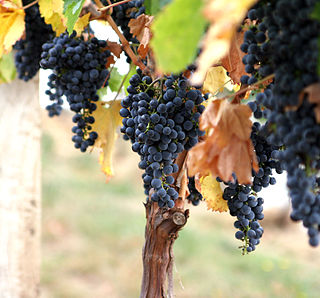
The annual growth cycle of grapevines is the process that takes place in the vineyard each year, beginning with bud break in the spring and culminating in leaf fall in autumn followed by winter dormancy. From a winemaking perspective, each step in the process plays a vital role in the development of grapes with ideal characteristics for making wine. Viticulturalists and vineyard managers monitor the effect of climate, vine disease and pests in facilitating or impeding the vine's progression from bud break, flowering, fruit set, veraison, harvesting, leaf fall and dormancy-reacting if need be with the use of viticultural practices like canopy management, irrigation, vine training and the use of agrochemicals. The stages of the annual growth cycle usually become observable within the first year of a vine's life. The amount of time spent at each stage of the growth cycle depends on a number of factors-most notably the type of climate and the characteristics of the grape variety.
This glossary of viticultural terms list some of terms and definitions involved in growing grapes for use in winemaking.
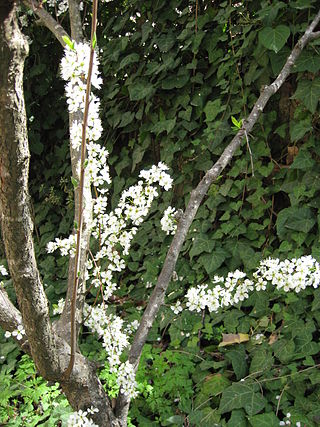
Water sprouts or water shoots are shoots that arise from the trunk of a tree or from branches that are several years old, from latent buds. The latent buds might be visible on the bark of the tree, or submerged under the bark as epicormic buds. They are sometimes called suckers, although that term is more correctly applied to shoots that arise from below ground, from the roots, and a distance from the trunk. Vigorous upright water sprouts often develop in response to damage or pruning.

Tomato grafting is a horticulture technique that has been utilized in Asia and Europe for greenhouse and high tunnel production and is gaining popularity in the United States. Typically, stock or rootstock are selected for their ability to resist infection by certain soilborne pathogens or their ability to increase vigor and fruit yield. The scion of the grafted tomato represents the upper portion of the plant and is selected for its fruit quality characteristics. There are several methods for grafting tomatoes and they have certain advantages and disadvantages. Once the grafts are made, the plants are moved into a chamber or environment with high relative humidity (>90%) and low light levels to reduce water stress in the scion while the graft union forms.

The propagation of grapevines is an important consideration in commercial viticulture and winemaking. Grapevines, most of which belong to the Vitis vinifera family, produce one crop of fruit each growing season with a limited life span for individual vines. While some centenarian old vine examples of grape varieties exist, most grapevines are between the ages of 10 and 30 years. As vineyard owners seek to replant their vines, a number of techniques are available which may include planting a new cutting that has been selected by either clonal or mass (massal) selection. Vines can also be propagated by grafting a new plant vine upon existing rootstock or by layering one of the canes of an existing vine into the ground next to the vine and severing the connection when the new vine develops its own root system.
Mtevandidi is an indigenous red grape variety from the region of Guria in the country of Georgia, primarily used for producing table wine. It is known also by the synonyms Akido, Achido, Didd Mtevana, Didmtevana, and Didtevano. There are no written sources regarding the origin of Mtevandidi. Botanical and agricultural features suggest that this variety is indigenous to Georgia.
Topophysis occurs when scions, buddings, or root cuttings continue to grow in the same way after grafting as they had while growing on the ortet.
Nurse grafting is a method of plant propagation that is used for hard-to-root plant material. If a desirable selection cannot be grown from seed, it must be propagated asexually (cloned) in order to be genetically identical to the parent. Nurse grafting allows a scion to develop its own roots instead of being grafted to a rootstock.

